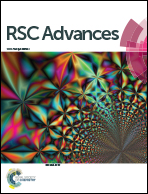Study on the preparation and photocatalytic oxidation properties of TiO2/nano-Fe0 photocatalysts
Abstract
TiO2/nano-Fe0 composite photocatalysts were prepared via a liquid phase reduction deposition method using anatase nano-TiO2 as a deposition substrate. The morphology and structure of TiO2/nano-Fe0 photocatalysts were characterized by scanning electron microscopy (SEM), transmission electron microscopy (TEM), X-ray diffraction (XRD) and UV-vis absorption spectra. The results showed that this composite photocatalyst can be homogeneously distributed and forms a jellyfish structure after combining with the TiO2 nanoparticles. The composite of nano-Fe0 and TiO2 could effectively compensate the consumption of nano-Fe0 and promote the generation of hydroxyl radicals (·OH) by a synergistic effect and the dynamic circulation reaction mechanism. Furthermore, the formation of a heterojunction structure between nano-Fe0 and TiO2 not only makes this composite photocatalyst have a higher catalytic efficiency in the visible region by the photo-response redshift effect, but also blocks the recombination of the photogenerated electron–hole pairs. The degradation efficiency for the Acid Red B solution was used to evaluate the activity of this composite photocatalyst. The effects of pH, dissolved oxygen and nano-Fe0 loading ratio on degradation efficiency of the Acid Red B were investigated and optimized. This composite photocatalyst possessed the highest photocatalytic activity under acidic and oxic conditions with the optimal loading of Fe0 of 10 wt%. In addition, TiO2/nano-Fe0 shows a higher catalytic activity than TiO2 or nano-Fe0 alone. The XRD patterns of catalysts before and after reaction proved that this composite photocatalyst was durable and stable, which is due to the dynamic circulation reaction mechanism.


 Please wait while we load your content...
Please wait while we load your content...